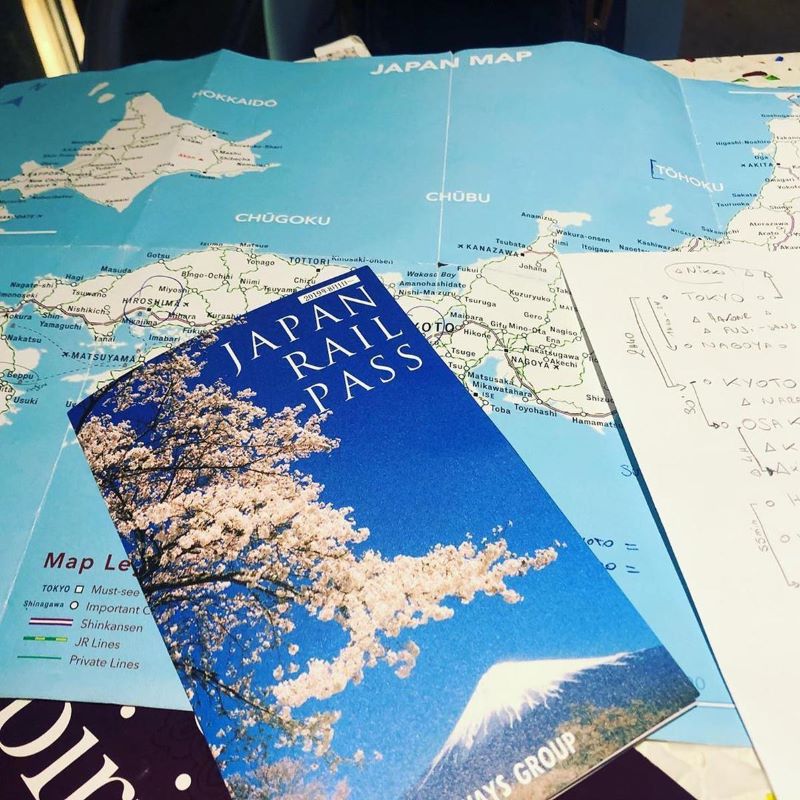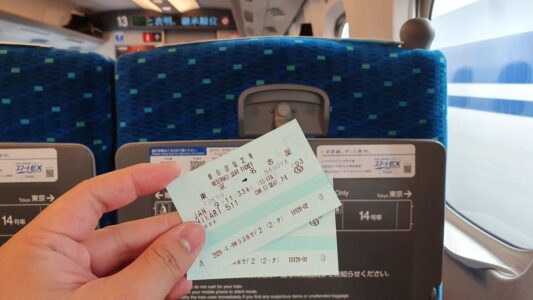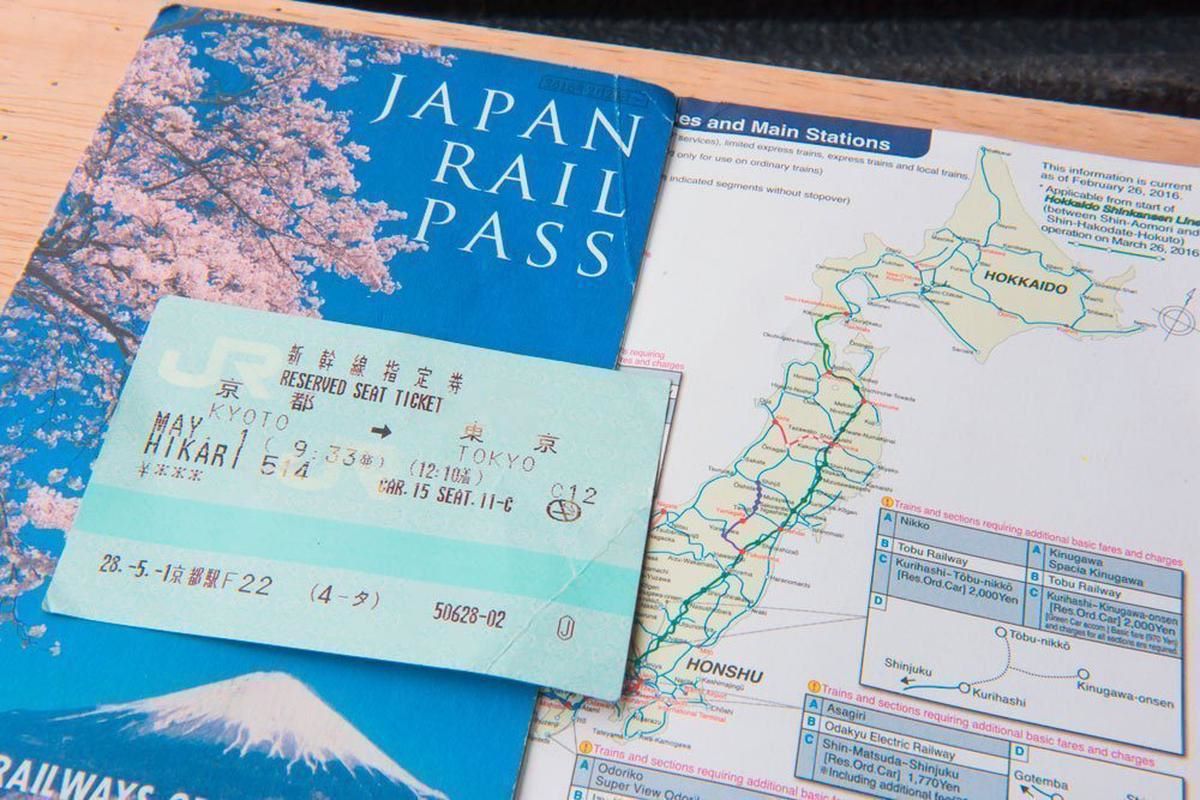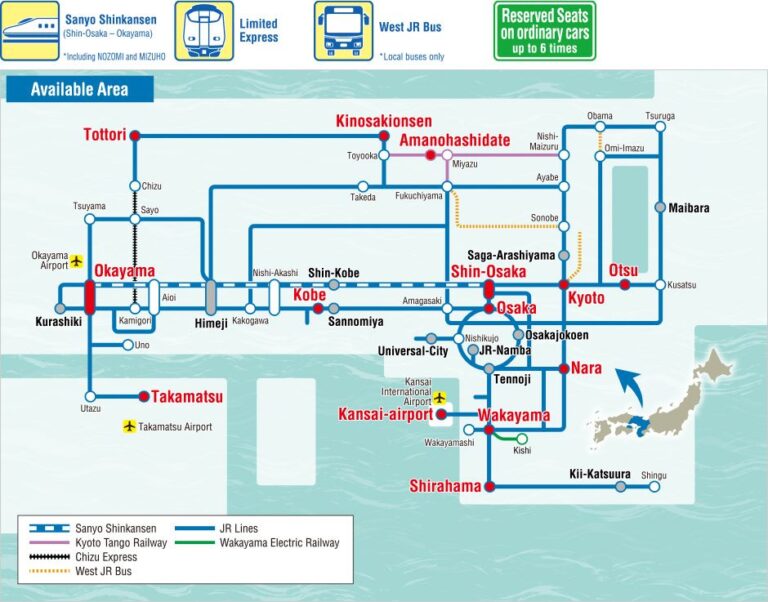Are you ready to embark on a journey through Japan’s stunning landscape and vibrant culture? If so, the Japan Rail Pass is your ticket to an unrestricted adventure.
What Is the Japan Rail Pass?

The Japan Rail Pass is a discount ticket that grants you access to the Japan Railways (JR) network across the country. With this pass, you can hop aboard the shinkansen (bullet train), local trains, and the Narita Express, which connects Narita Airport and Tokyo.
There are 2 types of Japan Rail Passes to choose from Ordinary or the Green pass (first class). The Ordinary pass allows you to travel on local, rapid trains and shinkansen (excluding express shinkansen called the Nozomi), while the Green pass grants you first-class access to both local and all shinkansen trains.
The Japan Rail Pass is an excellent choice for travelers who plan on traversing a significant portion of Japan. It can save you a substantial amount of money on transportation costs, especially if you plan on taking the shinkansen, which can be pricey when purchased separately.
How to Use the Japan Rail Pass

Using the Japan Rail Pass is a breeze. Simply present your pass to the staff member when you board the train, and you can travel on the JR network across Japan.
Before you can use the Japan Rail Pass, you must purchase it in advance and activate it before your arrival in Japan. You can purchase the pass online or through a travel agent, and you must specify the date that you want the pass to start.
Once you arrive in Japan, you must exchange your Japan Rail Pass voucher for the actual pass at a JR Exchange Office. These offices are located at major airports and train stations throughout the country, including Narita Airport and Tokyo Station. To exchange your voucher for the pass, you must present your voucher and passport.
Tips for Using the Japan Rail Pass
Here are a few tips to help you get the most out of your Japan Rail Pass:
- Plan your itinerary in advance: The Japan Rail Pass is an excellent value if you’re planning to cover a lot of ground in Japan. Plan your itinerary in advance to make the most of your pass andensure that you’re able to visit all of the places you want to see.
- Consider the Green pass: If you’re planning to take the shinkansen, the Green pass (first class) may be worth the extra cost. The Green pass offers more comfortable seating and a quieter environment, and it may be a good option if you’re planning to travel long distances.
- Make reservations in advance: If you’re planning to travel during peak season or on a holiday, it’s a good idea to make reservations for your train trips in advance. This will ensure that you have a seat on the train and help you avoid long lines at the ticket office.
- Take advantage of the pass’s flexibility: The Japan Rail Pass is not only a convenient way to travel, but it also allows you to be flexible with your itinerary. If you change your mind about your destination or want to stay longer in a particular place, you can easily alter your plans without worrying about purchasing additional tickets.
Overall, the Japan Rail Pass is an excellent value for travelers who want to explore Japan by train. With unlimited travel on the JR network, including the shinkansen, local trains, and the Narita Express, it can save you money on transportation costs and make it easier to get around the country. Just be sure to plan your itinerary in advance, consider the Green pass if you’re planning to take the shinkansen, and make reservations in advance if you’re traveling during peak season or on a holiday. Happy travels!
How Much Is The JR rail Pass?
The price of the Japan Rail Pass depends on the type of pass you choose and the duration of your stay in Japan. The Japan Rail Pass is available in 7-day, 14-day, and 21-day versions, and the price varies depending on which type of pass you choose.
The Ordinary pass, which allows you to travel on local and rapid trains, is available for the following prices:
- 7-day pass: 29,110 yen (adult) / 14,550 yen (child)
- 14-day pass: 46,390 yen (adult) / 23,190 yen (child)
- 21-day pass: 59,350 yen (adult) / 29,670 yen (child)
The Green pass, which allows you to travel on local and shinkansen trains in first class, is available for the following prices:
- 7-day pass: 38,880 yen (adult) / 19,440 yen (child)
- 14-day pass: 62,950 yen (adult) / 31,470 yen (child)
- 21-day pass: 81,870 yen (adult) / 40,930 yen (child)
Children’s fares are available for children aged 6 to 11. Children aged 5 and under can travel for free.
Please note that these prices are subject to change, and the Japan Rail Pass can only be purchased outside of Japan. If you’re planning a trip to Japan, be sure to check the current prices before purchasing your pass.
Is The JR Rail Pass Worth It?
The Japan Rail Pass (JR Pass) can be a good value for travelers who plan to cover a lot of ground in Japan and use the Japan Railways (JR) network extensively. The JR Pass offers unlimited travel on JR trains, including the shinkansen (bullet train), local trains, and the Narita Express, which runs between Narita Airport and Tokyo.
If you’re planning to travel on the shinkansen and/or local trains extensively, the JR Pass can save you money on transportation costs compared to purchasing individual tickets. For example, a one-way ticket from Tokyo to Kyoto on the shinkansen costs around 14,000 yen, so if you’re planning to take the shinkansen multiple times during your trip, the JR Pass can quickly pay for itself.
However, the JR Pass is not necessarily the best option for everyone. If you’re only planning to stay in one city or region of Japan, or if you’re planning to use other forms of transportation (such as buses or subways) extensively, the JR Pass might not be the most cost-effective option. It’s important to consider your specific travel plans and budget when deciding whether the JR Pass is worth it for you.
Overall, the JR Pass can be a good value for travelers who plan to cover a lot of ground in Japan and use the JR network extensively. However, it’s important to carefully consider your travel plans and budget before deciding whether the JR Pass is the right option for you.
Can I ride The Fastest Shinkansen With A JR Rail Pass?

Yes, you can ride the fastest bullet trains (shinkansen) with the Japan Rail Pass (JR Pass). The JR Pass offers unlimited travel on the JR network, including the shinkansen, local trains, and the Narita Express, which connects Narita Airport and Tokyo.
There are several different types of shinkansen trains in Japan, and the JR Pass allows you to ride any of them. The fastest shinkansen trains are the Nozomi and Mizuho trains, which operate on the Tokaido, Sanyo, and Kyushu Shinkansen lines. These trains have a top speed of around 270 km/h (168 mph) and offer a fast and convenient way to travel between major cities in Japan.
There are two types of JR Passes available: the Ordinary pass (which allows you to travel on local and rapid trains) and the Green pass (which allows you to travel on local and shinkansen trains in first class). Both types of passes allow you to ride the shinkansen, but the Green pass offers more comfortable seating and a quieter environment compared to standard class.
What’s The Green Car?

A Green Car is a type of first class train car that is available on some trains in Japan. Green Cars offer more comfortable seating and a quieter environment compared to standard class (called “Ordinary Cars” in Japan).
Green Cars are typically available on local and long-distance trains, including the shinkansen (bullet train). They are often equipped with wider seats, more legroom, and other amenities such as power outlets and armrests. Green Cars may also have a separate lounge area or bar where passengers can relax or socialize.
To ride in a Green Car, you’ll need to purchase a Green Car ticket or use a pass that includes access to Green Cars. The Japan Rail Pass (JR Pass) is one option that allows you to ride in Green Cars. There are two types of JR Passes available: the Ordinary pass (which allows you to travel on local and rapid trains) and the Green pass (which allows you to travel on local and shinkansen trains in first class).
Green Car tickets and passes are generally more expensive than standard class tickets and passes. However, they may be worth the extra cost if you want to travel in comfort and style while exploring Japan by train. Just be sure to plan your itinerary in advance and consider your transportation needs when deciding whether a Green Car ticket or pass is right for you.
Can you use JR Pass on Tokyo Metro?
No, the Japan Rail Pass (JR Pass) cannot be used on the Tokyo Metro subway system. The JR Pass is only valid on the Japan Railways (JR) network, which includes local trains, the shinkansen (bullet train), and the Narita Express (which connects Narita Airport and Tokyo). It does not cover travel on non-JR trains, such as the Tokyo Metro subway or other private railways.
If you want to ride the Tokyo Metro subway, you’ll need to purchase a separate ticket or pass. Tokyo Metro offers a variety of ticket and pass options, including single-ride tickets, day passes, and prepaid IC cards (such as Suica or Pasmo). These tickets and passes can be purchased at Tokyo Metro stations or at select convenience stores and ticket vending machines.
To use the Tokyo Metro subway, you’ll need to purchase a ticket or pass and pass through the ticket gates at the station. If you’re using a single-ride ticket or a day pass, you’ll need to insert the ticket into the ticket gate to enter the station. If you’re using an IC card, you’ll need to tap the card on the card reader to enter the station.
Overall, the JR Pass is an excellent value for travelers who want to explore Japan by train. However, if you’re planning to use the Tokyo Metro subway or other non-JR trains, you’ll need to purchase separate tickets or passes. Just be sure to plan your itinerary in advance and consider your transportation needs when deciding which tickets or passes to purchase.
Can I use JR Pass from Tokyo to Osaka Or Kyoto?

Yes, you can use the Japan Rail Pass (JR Pass) to travel from Tokyo to Osaka or Kyoto by train. The JR Pass offers unlimited travel on the Japan Railways (JR) network, including the shinkansen (bullet train), local trains, and the Narita Express (which connects Narita Airport and Tokyo).
To travel from Tokyo to Osaka by train, you can take the shinkansen from Tokyo Station to Shin-Osaka Station. The shinkansen is a fast and convenient way to travel between major cities in Japan, and it has a top speed of around 270 km/h (168 mph). The journey from Tokyo to Osaka by shinkansen takes about 2.5 hours.
Can I buy a JR Rail Pass Inside Japan?
Note: You can now buy a Japan rail pass within Japan but it is more expensive.
No, the Japan Rail Pass (JR Pass) cannot be purchased in Japan. It can only be purchased outside of Japan, and it must be activated within 90 days of the purchase date.
The JR Pass is a discounted train pass that allows you to travel unlimitedly on the Japan Railways (JR) network, including the shinkansen (bullet train), local trains, and the Narita Express (which connects Narita Airport and Tokyo). It is only available to foreign tourists who are visiting Japan on a temporary visitor visa.
To purchase a JR Pass, you can visit the official website of the Japan Railways Group or contact a travel agent that specializes in selling the JR Pass. The JR Pass is available in a variety of durations (7-day, 14-day, or 21-day), and you’ll need to specify the type of pass you want (Ordinary or Green) and the date that you want the pass to start. You’ll also need to provide your passport information and other personal details when purchasing the pass.
Once you’ve purchased the pass, you’ll receive a voucher that you’ll need to exchange for the actual pass once you arrive in Japan. You can exchange the voucher at a JR Exchange Office, which are located at major airports and train stations throughout the country, including Narita Airport and Tokyo Station. You’ll need to present your voucher and passport to exchange the voucher for the pass.
Which Stations Can I Exchange My Voucher For A JR Rail Pass?
Here is a list of stations in Japan where you can exchange your Japan Rail Pass (JR Pass) voucher for the actual pass:
- Narita Airport Terminal 1 Station
- Narita Airport Terminal 2·3 Station
- Haneda Airport International Terminal Station
- New Chitose Airport Station
- Kansai Airport Station
- Chubu Centrair International Airport Station
- Fukuoka Airport Station
- Naha Airport Station
- Sapporo Station
- Sendai Station
- Niigata Station
- Toyama Station
- Kanazawa Station
- Kyoto Station
- Osaka Station
- Kobe Station
- Hiroshima Station
- Takamatsu Station
- Matsuyama Station
- Kochi Station
- Fukuoka Station
- Kagoshima-Chuo Station
- Nagaoka Station
- Niigata Station
- Omiya Station
- Shinjuku Station
- Yokohama Station
- Ueno Station
- Tokyo Station
- Shibuya Station
- Shinagawa Station
- Yokohama Station
- Hamamatsucho Station
- Nihonbashi Station
- Asakusa Station
- Ueno Station
- Tokyo Station
- Yokohama Station
This is not an exhaustive list, as there are other JR Exchange Offices located at major airports and train stations throughout the country. To find the nearest JR Exchange Office, you can check the official website of the Japan Railways Group or ask a staff member at the train station.
To exchange your JR Pass voucher for the actual pass, you’ll need to present your voucher and passport at the JR Exchange Office. The staff will check your documents and activate the pass for you. Once the pass is activated, you can start using it to travel on the JR network. Just be sure to follow the instructions on the pass and check the timetable for train schedules and route information.
What Other JR Area Passes Are There?
In addition to the Japan Rail Pass (JR Pass), which allows you to travel unlimitedly on the Japan Railways (JR) network, there are several other regional JR passes available that allow you to travel within specific areas of Japan. These passes are often more cost-effective than the JR Pass if you’re only planning to visit a specific region or if you’re only interested in traveling on local and rapid trains.
Here are some examples of regional JR passes that are available:
- Kansai Area Pass: This pass allows you to travel unlimitedly on local and rapid trains within the Kansai region, which includes Osaka, Kyoto, Kobe, and Nara. The pass is available in a variety of durations (1-day, 2-day, or 3-day) and can be purchased online or through a travel agent.
- Hokkaido Rail Pass: This pass allows you to travel unlimitedly on local and rapid trains within Hokkaido, which is the northernmost island of Japan. The pass is available in a variety of durations (3-day, 4-day, or 5-day) and can be purchased online or through a travel agent.
- Kyushu Rail Pass: This pass allows you to travel unlimitedly on local and rapid trains within Kyushu, which is the southernmost island of Japan. The pass is available in a variety of durations (3-day, 4-day, or 5-day) and can be purchased online or through a travel agent.
- Northern Kyushu Rail Pass: This pass allows you to travel unlimitedly on local and rapid trains within the northern part of Kyushu, which includes Fukuoka, Kitakyushu, and Kumamoto. The pass is available in a variety of durations (3-day, 4-day, or 5-day) and can be purchased online or through a travel agent.
- East Japan Rail Pass: This pass allows you to travel unlimitedly on local and rapid trains within the eastern part of Japan, which includes Tokyo, Yokohama, and Nikko. The pass is available in a variety of durations (3-day, 4-day, or 5-day) and can be purchased online or through a travel agent.
Overall, regional JR passes are a convenient and cost-effective way to travel within specific areas of Japan. They offer unlimited travel on local and rapid trains and can be purchased in advance online or through a travel agent. Just be sure to plan your itinerary in advance and consider your transportation needs when deciding which pass is right for you.




